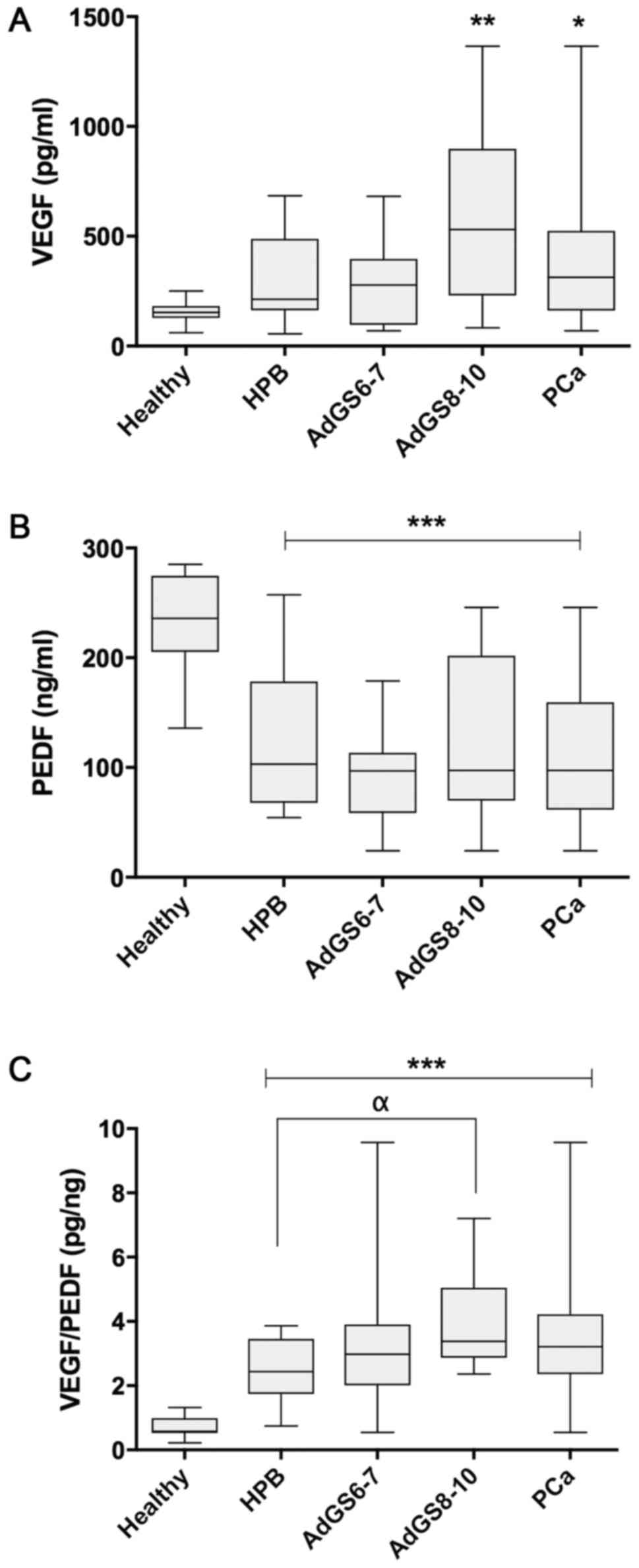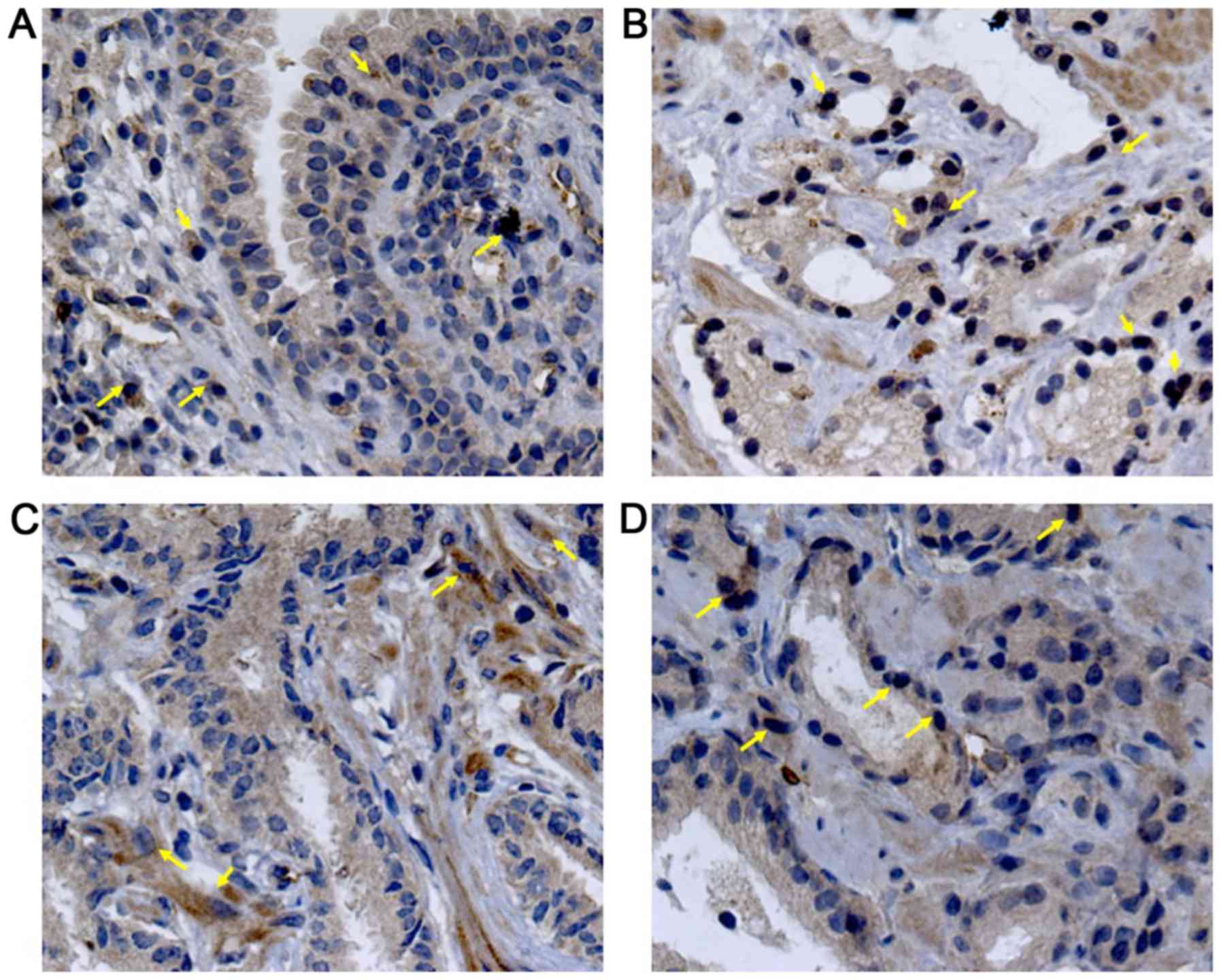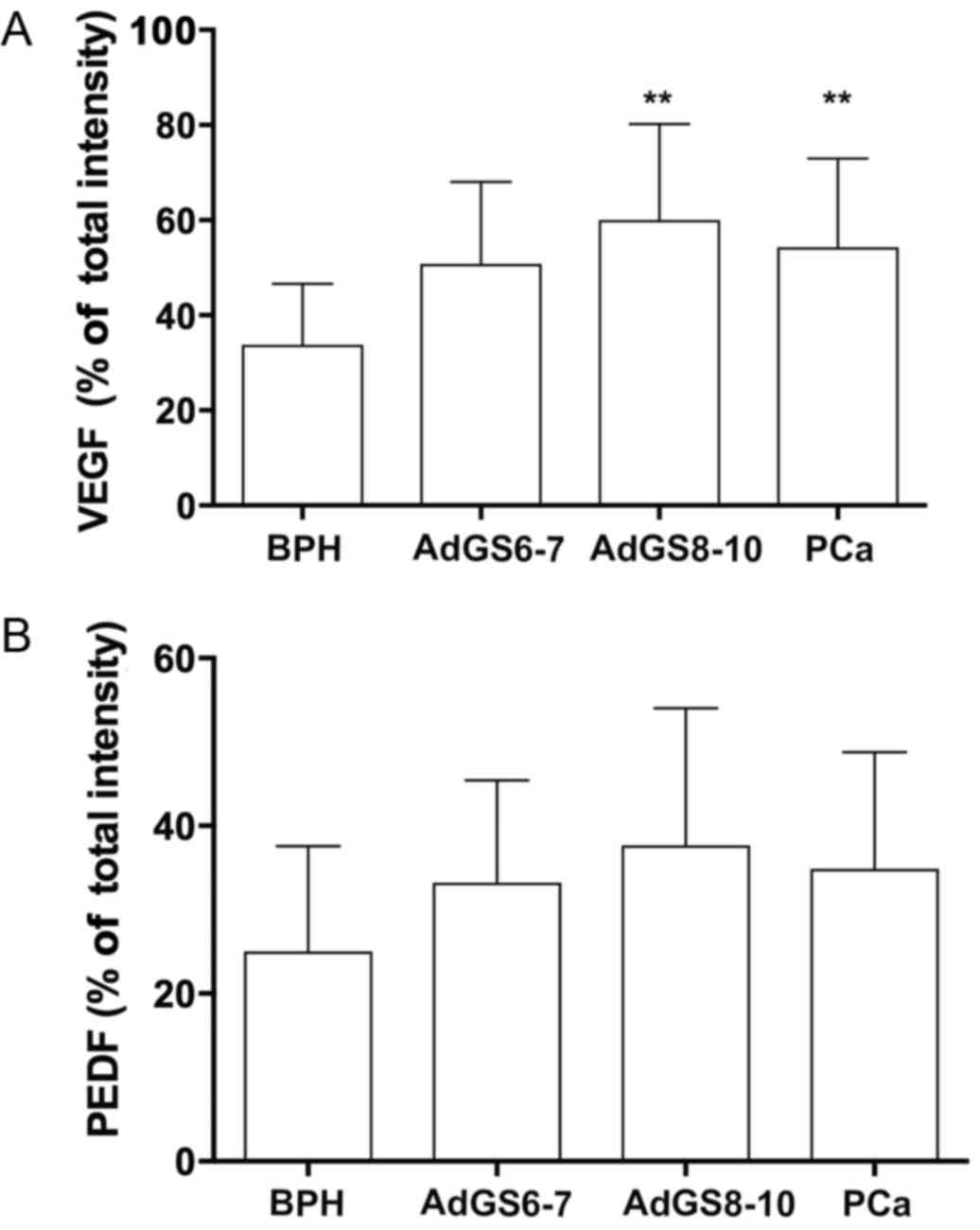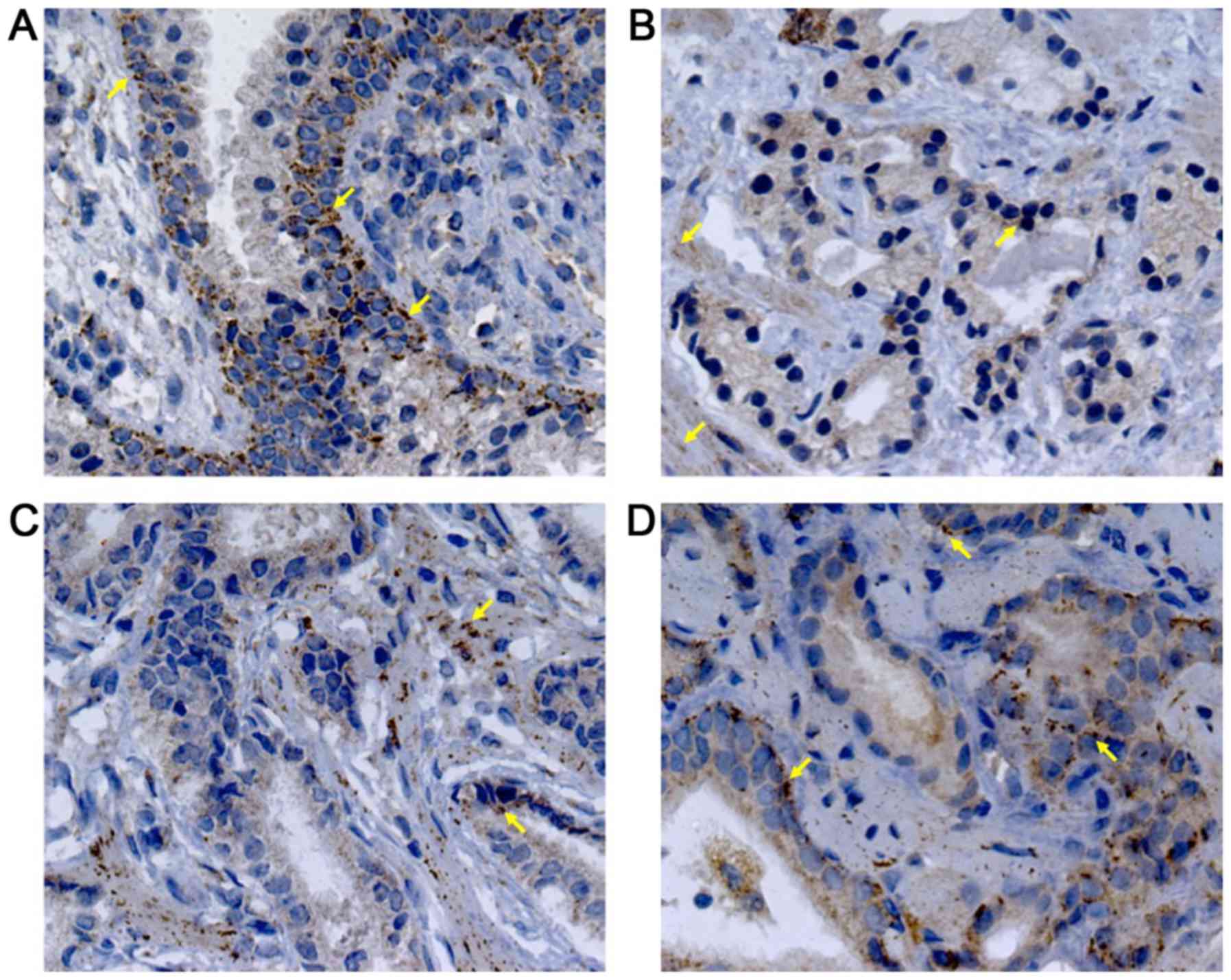|
1
|
Brawley OW: Trends in prostate cancer in
the United States. J Natl Cancer Inst Monogr. 2012:152–156. 2012.
View Article : Google Scholar : PubMed/NCBI
|
|
2
|
Gomez-Guerra LS, Martinez-Fierro ML,
Alcantara-Aragon V, Ortiz-Lopez R, Martinez-Villarreal RT,
Morales-Rodriguez IB, Garza-Guajardo R, Ponce-Camacho MA and
Rojas-Martinez A: Population based prostate cancer screening in
north Mexico reveals a high prevalence of aggressive tumors in
detected cases. BMC Cancer. 9:912009. View Article : Google Scholar : PubMed/NCBI
|
|
3
|
Thompson IM, Pauler DK, Goodman PJ, Tangen
CM, Lucia MS, Parnes HL, Minasian LM, Ford LG, Lippman SM, Crawford
ED, et al: Prevalence of prostate cancer among men with a
prostate-specific antigen level < or =4.0 ng per milliliter. N
Engl J Med. 350:2239–2246. 2004. View Article : Google Scholar : PubMed/NCBI
|
|
4
|
Catalona WJ, Richie JP, Ahmann FR, Hudson
MA, Scardino PT, Flanigan RC, DeKernion JB, Ratliff TL, Kavoussi
LR, Dalkin BL, et al: Comparison of digital rectal examination and
serum prostate specific antigen in the early detection of prostate
cancer: Results of a multicenter clinical trial of 6,630 men. J
Urol. 197:S200–S207. 2017. View Article : Google Scholar : PubMed/NCBI
|
|
5
|
Liu ZQ, Fang JM, Xiao YY, Zhao Y, Cui R,
Hu F and Xu Q: Prognostic role of vascular endothelial growth
factor in prostate cancer: A systematic review and meta-analysis.
Int J Clin Exp Med. 8:2289–2298. 2015.PubMed/NCBI
|
|
6
|
Gyftopoulos K, Vourda K, Sakellaropoulos
G, Perimenis P, Athanasopoulos A and Papadaki E: The angiogenic
switch for vascular endothelial growth factor-A and
cyclooxygenase-2 in prostate carcinoma: Correlation with
microvessel density, androgen receptor content and Gleason grade.
Urol Int. 87:464–469. 2011. View Article : Google Scholar : PubMed/NCBI
|
|
7
|
Nordby Y, Andersen S, Richardsen E, Ness
N, Al-Saad S, Melbø-Jørgensen C, Patel HR, Dønnem T, Busund LT and
Bremnes RM: Stromal expression of VEGF-A and VEGFR-2 in prostate
tissue is associated with biochemical and clinical recurrence after
radical prostatectomy. Prostate. 75:1682–1693. 2015. View Article : Google Scholar : PubMed/NCBI
|
|
8
|
Duque JL, Loughlin KR, Adam RM, Kantoff P,
Mazzucchi E and Freeman MR: Measurement of plasma levels of
vascular endothelial growth factor in prostate cancer patients:
Relationship with clinical stage, Gleason score, prostate volume,
and serum prostate-specific antigen. Clinics (Sao Paulo).
61:401–408. 2006. View Article : Google Scholar : PubMed/NCBI
|
|
9
|
Silva SA, Gobbo MG, Pinto-Fochi ME,
Rafacho A, Taboga SR, Almeida EA, Góes RM and Ribeiro DL: Prostate
hyperplasia caused by long-term obesity is characterized by high
deposition of extracellular matrix and increased content of MMP-9
and VEGF. Int J Exp Pathol. 96:21–30. 2015. View Article : Google Scholar : PubMed/NCBI
|
|
10
|
Stefanou D, Batistatou A, Kamina S,
Arkoumani E, Papachristou DJ and Agnantis NJ: Expression of
vascular endothelial growth factor (VEGF) and association with
microvessel density in benign prostatic hyperplasia and prostate
cancer. In vivo. 18:155–160. 2004.PubMed/NCBI
|
|
11
|
Walsh K, Sriprasad S, Hopster D, Codd J
and Mulvin D: Distribution of vascular endothelial growth factor
(VEGF) in prostate disease. Prostate Cancer Prostatic Dis.
5:119–122. 2002. View Article : Google Scholar : PubMed/NCBI
|
|
12
|
Botelho F, Pina F and Lunet N: VEGF and
prostatic cancer: A systematic review. Eur J Cancer Prev.
19:385–392. 2010. View Article : Google Scholar : PubMed/NCBI
|
|
13
|
Peyromaure M, Goulvestre C, Fulla Y,
Grabar S, Debré B and Dinh-Xuan AT: Serum levels of vascular
endothelial growth factor in patients undergoing prostate biopsy
for suspicion of prostate cancer. Urology. 66:687–691. 2005.
View Article : Google Scholar : PubMed/NCBI
|
|
14
|
Becerra SP and Notario V: The effects of
PEDF on cancer biology: Mechanisms of action and therapeutic
potential. Nat Rev Cancer. 13:258–271. 2013. View Article : Google Scholar : PubMed/NCBI
|
|
15
|
Halin S, Wikström P, Rudolfsson SH,
Stattin P, Doll JA, Crawford SE and Bergh A: Decreased pigment
epithelium-derived factor is associated with metastatic phenotype
in human and rat prostate tumors. Cancer Res. 64:5664–5671. 2004.
View Article : Google Scholar : PubMed/NCBI
|
|
16
|
Wu QJ, Gong CY, Luo ST, Zhang DM, Zhang S,
Shi HS, Lu L, Yan HX, He SS, Li DD, et al: AAV-mediated human PEDF
inhibits tumor growth and metastasis in murine colorectal
peritoneal carcinomatosis model. BMC Cancer. 12:1292012. View Article : Google Scholar : PubMed/NCBI
|
|
17
|
Gong Q, Qiu S, Li S, Ma Y, Chen M, Yao Y,
Che D, Feng J, Cai W, Ma J, et al: Proapoptotic PEDF functional
peptides inhibit prostate tumor growth-a mechanistic study. Biochem
Pharmacol. 92:425–437. 2014. View Article : Google Scholar : PubMed/NCBI
|
|
18
|
Mirochnik Y, Aurora A, Schulze-Hoepfner
FT, Deabes A, Shifrin V, Beckmann R, Polsky C and Volpert OV: Short
pigment epithelial-derived factor-derived peptide inhibits
angiogenesis and tumor growth. Clin Cancer Res. 15:1655–1663. 2009.
View Article : Google Scholar : PubMed/NCBI
|
|
19
|
Qingyi Z, Lin Y, Junhong W, Jian S,
Weizhou H, Long M, Zeyu S and Xiaojian G: Unfavorable prognostic
value of human PEDF decreased in high-grade prostatic
intraepithelial neoplasia: A differential proteomics approach.
Cancer Invest. 27:794–801. 2009. View Article : Google Scholar : PubMed/NCBI
|
|
20
|
Byrne JC, Downes MR, O'Donoghue N, O'Keane
C, O'Neill A, Fan Y, Fitzpatrick JM, Dunn M and Watson RW: 2D-DIGE
as a strategy to identify serum markers for the progression of
prostate cancer. J Proteome Res. 8:942–957. 2009. View Article : Google Scholar : PubMed/NCBI
|
|
21
|
Grossniklaus HE, Zhang Q, You S, McCarthy
C, Heegaard S and Coupland SE: Metastatic ocular melanoma to the
liver exhibits infiltrative and nodular growth patterns. Hum
Pathol. 57:165–175. 2016. View Article : Google Scholar : PubMed/NCBI
|
|
22
|
Shi D, Xie F, Zhang Y, Tian Y, Chen W, Fu
L, Wang J, Guo W, Kang T, Huang W and Deng W: TFAP2A regulates
nasopharyngeal carcinoma growth and survival by targeting HIF-1α
signaling pathway. Cancer Prev Res (Phila). 7:266–277. 2014.
View Article : Google Scholar : PubMed/NCBI
|
|
23
|
Jeng KS, Sheen IS, Jeng WJ and Su JC: PEDF
effectively decreases VEGF to PEDF messenger RNA ratio of the inner
edge of rat hepatocellular carcinoma induced by diethyl
nitrosamine-an ‘in vivo’ study. Hepatogastroenterology.
59:1484–1490. 2012.PubMed/NCBI
|
|
24
|
Yang H, Xu Z, Iuvone PM and Grossniklaus
HE: Angiostatin decreases cell migration and vascular endothelium
growth factor (VEGF) to pigment epithelium derived factor (PEDF)
RNA ratio in vitro and in a murine ocular melanoma model. Mol Vis.
12:511–517. 2006.PubMed/NCBI
|
|
25
|
Bai YJ, Huang LZ, Zhou AY, Zhao M, Yu WZ
and Li XX: Antiangiogenesis effects of endostatin in retinal
neovascularization. J Ocul Pharmacol Ther. 29:619–626. 2013.
View Article : Google Scholar : PubMed/NCBI
|
|
26
|
Regulation on Research for Health of the
General Health Law. http://www.salud.gob.mx/unidades/cdi/nom/compi/rlgsmis.html
|
|
27
|
Official Mexican Norm number
NOM-253-SSA1-2012, for the disposal of human blood and its
components for therapeutic purposes. http://www.cnts.salud.gob.mx/descargas/PROY_A_NOM_2-1.pdf
|
|
28
|
Jamaspishvili T, Kral M, Khomeriki I,
Student V, Kolar Z and Bouchal J: Urine markers in monitoring for
prostate cancer. Prostate Cancer Prostatic Dis. 13:12–19. 2010.
View Article : Google Scholar : PubMed/NCBI
|
|
29
|
Kim NH, Oh JH, Seo JA, Lee KW, Kim SG,
Choi KM, Baik SH, Choi DS, Kang YS, Han SY, et al: Vascular
endothelial growth factor (VEGF) and soluble VEGF receptor FLT-1 in
diabetic nephropathy. Kidney Int. 67:167–177. 2005. View Article : Google Scholar : PubMed/NCBI
|
|
30
|
Shariat SF, Anwuri VA, Lamb DJ, Shah NV,
Wheeler TM and Slawin KM: Association of preoperative plasma levels
of vascular endothelial growth factor and soluble vascular cell
adhesion molecule-1 with lymph node status and biochemical
progression after radical prostatectomy. J Clin Oncol.
22:1655–1663. 2004. View Article : Google Scholar : PubMed/NCBI
|
|
31
|
Li H, Kantoff PW, Ma J, Stampfer MJ and
George DJ: Prediagnostic plasma vascular endothelial growth factor
levels and risk of prostate cancer. Cancer Epidemiol Biomarkers
Prev. 14:1557–1561. 2005. View Article : Google Scholar : PubMed/NCBI
|
|
32
|
Mao K, Badoual C, Camparo P, Delongchamps
NB, Vieillefond A, Dinh-Xuan AT and Peyromaure M: The prognostic
value of vascular endothelial growth factor (VEGF)-A and its
receptor in clinically localized prostate cancer: A prospective
evaluation in 100 patients undergoing radical prostatectomy. Can J
Urol. 15:4257–4262. 2008.PubMed/NCBI
|
|
33
|
Soulitzis N, Karyotis I, Delakas D and
Spandidos DA: Expression analysis of peptide growth factors VEGF
FGF2, TGFB1, EGF and IGF1 in prostate cancer and benign prostatic
hyperplasia. Int J Oncol. 29:305–314. 2006.PubMed/NCBI
|
|
34
|
Lekas A, Lazaris AC, Deliveliotis C,
Chrisofos M, Zoubouli C, Lapas D, Papathomas T, Fokitis I and
Nakopoulou L: The expression of hypoxia-inducible factor-1alpha
(HIF-1alpha) and angiogenesis markers in hyperplastic and malignant
prostate tissue. Anticancer Res. 26:2989–2993. 2006.PubMed/NCBI
|
|
35
|
Shih SJ, Dall'Era MA, Westphal JR, Yang J,
Sweep CG, Gandour-Edwards R and Evans CP: Elements regulating
angiogenesis and correlative microvessel density in benign
hyperplastic and malignant prostate tissue. Prostate Cancer
Prostatic Dis. 6:131–137. 2003. View Article : Google Scholar : PubMed/NCBI
|
|
36
|
Voss M, Trojan L, Steidler A, Weiss C,
Grobholz R, Alken P and Michel MS: Serum vascular endothelial
growth factor C level in patients with prostate cancer and benign
prostatic hyperplasia. Anal Quant Cytol Histol. 30:199–202.
2008.PubMed/NCBI
|
|
37
|
Matsui T, Ojima A, Higashimoto Y, Taira J,
Fukami K and Yamagishi SI: Pigment epithelium-derived factor
inhibits caveolin-induced interleukin-8 gene expression and
proliferation of human prostate cancer cells. Oncol Lett.
10:2644–2648. 2015.PubMed/NCBI
|
|
38
|
Nelius T, Martinez-Marin D, Hirsch J,
Miller B, Rinard K, Lopez J, de Riese W and Filleur S: Pigment
epithelium-derived factor expression prolongs survival and enhances
the cytotoxicity of low-dose chemotherapy in castration-refractory
prostate cancer. Cell Death Dis. 5:e12102014. View Article : Google Scholar : PubMed/NCBI
|
|
39
|
Hirsch J, Johnson CL, Nelius T, Kennedy R,
Riese WD and Filleur S: PEDF inhibits IL8 production in prostate
cancer cells through PEDF receptor/phospholipase A2 and regulation
of NFκB and PPARγ. Cytokine. 55:202–210. 2011. View Article : Google Scholar : PubMed/NCBI
|
|
40
|
Nelius T, Samathanam C, Martinez-Marin D,
Gaines N, Stevens J, Hickson J, de Riese W and Filleur S: Positive
correlation between PEDF expression levels and macrophage density
in the human prostate. Prostate. 73:549–561. 2013. View Article : Google Scholar : PubMed/NCBI
|
|
41
|
Ide H, Yamagishi S, Lu Y, Sakamaki K,
Nakajima A, Horiuchi A, Kitamura K, Hisasue S, Muto S, Yamaguchi R
and Horie S: Circulating pigment epithelium-derived factor (PEDF)
is associated with pathological grade of prostate cancer.
Anticancer Res. 35:1703–1708. 2015.PubMed/NCBI
|
|
42
|
Doll JA, Stellmach VM, Bouck NP, Bergh AR,
Lee C, Abramson LP, Cornwell ML, Pins MR, Borensztajn J and
Crawford SE: Pigment epithelium-derived factor regulates the
vasculature and mass of the prostate and pancreas. Nat Med.
9:774–780. 2003. View
Article : Google Scholar : PubMed/NCBI
|
|
43
|
Carnagarin R, Dharmarajan AM and Dass CR:
PEDF-induced alteration of metabolism leading to insulin
resistance. Mol Cell Endocrinol. 401:98–104. 2015. View Article : Google Scholar : PubMed/NCBI
|
|
44
|
Cai J, Chen Z, Ruan Q, Han S, Liu L, Qi X,
Boye SL, Hauswirth WW, Grant MB and Boulton ME: γ-Secretase and
presenilin mediate cleavage and phosphorylation of vascular
endothelial growth factor receptor-1. J Biol Chem. 286:42514–42523.
2011. View Article : Google Scholar : PubMed/NCBI
|
|
45
|
Pollina EA, Legesse-Miller A, Haley EM,
Goodpaster T, Randolph-Habecker J and Coller HA: Regulating the
angiogenic balance in tissues. Cell Cycle. 7:2056–2070. 2008.
View Article : Google Scholar : PubMed/NCBI
|
|
46
|
Volpert OV, Zaichuk T, Zhou W, Reiher F,
Ferguson TA, Stuart PM, Amin M and Bouck NP: Inducer-stimulated Fas
targets activated endothelium for destruction by anti-angiogenic
thrombospondin-1 and pigment epithelium-derived factor. Nat Med.
8:349–357. 2002. View Article : Google Scholar : PubMed/NCBI
|


















